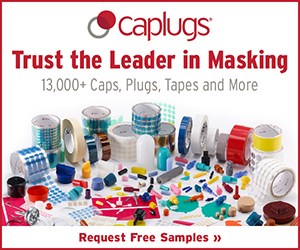On Thermoplastic Powder Coatings
Tim Brinner of IFS Coatings explains the difference between thermoplastic and thermosetting powder coatings, and discusses applications where thermoplastic powders can be used to greatest effect.
Q: What are thermoplastic powders and how are they different from thermoset powders?
There are two types of powder coating; thermosetting powders and thermoplastic powders. Thermosetting powders are talked about a lot and used by everyone from OEMs to job shops. When thermosetting powders are cured in the oven they crosslink and essentially create a whole new chemistry that can’t be changed. There are a range of chemistries — think polyester, epoxy, urethane etc. — and they are generally available in a huge range of colors and special effects.
Thermoplastic powders are perhaps less well known but just as interesting! Thermoplastic powders utilize longer chain molecules, and they do not crosslink. There are also different chemistries available with thermoplastic powders — for example, nylon and polyethylene — and while they are available in many different colors for very beautiful coatings, they are often used for their functional properties rather than wide-ranging aesthetics. Unlike thermosetting powders that crosslink and don’t melt again after cure, thermoplastics do melt again when exposed to high heat after cure.
Q: Have there been any breakthroughs in thermoplastic powder coatings recently?
When talking about the pros and cons of thermoplastic powder coatings, traditionally the outstanding impact resistance, corrosion resistance and UV performance were a tradeoff for lower scratch resistance. Thermoplastic powder coatings were always a great option in applications where the impact resistance was more important than the scratch resistance. Well, there have been some drastic breakthroughs in this department. Thermoplastic powder coatings can now provide scratch resistance performance much closer to conventional thermoset coatings. In extreme applications such as inground parts that are in contact with dirt and rocks, the scratch resistance of thermoplastic powders can be well past conventional thermoset. And this is opening up thermoplastic powders to new applications where scratch resistance is every bit as important as impact resistance. Trailers are an excellent example.
Q: What are good examples of thermoplastic powder coatings applications?
Thermoplastic powders are known for their excellent adhesion to metal substrates, outstanding mechanical and chemical performance, and they also deliver excellent weathering, so are used in a wide range of industries and applications. The most famous — or at least one of the most fun applications — are football helmet masks! If you have a 250-pound football player coming at you, you want tough protection — and, of course, team colors are also important.
A particularly unique technical advantage is that thermoplastic powder will flex and actually bend with the metal substrate. In fact, the metal will usually break well before the thermoplastic powder film. A great example of this is welded wire parts. You may think of it as impact resistance — and there is an element of that — however, welded wire parts have to flex and almost move. Take, for example, the coating on a shopping cart when a case of bottled water is tossed in. If it doesn’t flex, then it will crack and allow rust in — and there begins a whole host of other problems. A recent field study demonstrated this with some very interesting results.
We have all seen the stress shopping carts are put under — from exterior exposure in all kinds of weather to carts sent sailing into the arms of the corral or banging into other carts, shelving and more. IFS Coatings developed a new polyethylene thermoplastic and was approached to trial it against the incumbent thermosetting powders used on shopping carts at a major retailer.
A field test was organized and carts were coated with a single coat of Puroplaz PE21, as well as the three-coat, polyester-based incumbent coating system. The carts were placed amongst other carts at a busy major retailer in Galveston, Texas, in March 2021 (Galveston is known for its tough coastal climatic conditions).
Repeated impact not only causes chipping or coating removal, but in turn, causes exposure and potential for rust. Likewise, rust often occurs around the welds or joints, so the coatings need to deliver excellent impact resistance and corrosion resistance, offer UV protection and of course, look good.
After 3 months the results were fairly similar, however, as time progressed, the single coat Puroplaz PE21 displayed superior performance. One year later, the carts coated with Thermoplastic Puroplaz PE21 showed less damage, less rust, less removal of the coating and delivered a longer life product in a single coat. This ultimately reduced the need for recoating but also helps the retailer with their brand image for longer.
Q: How do I decide if thermoplastic powder is suitable for my application?
The 5 questions I always ask and answer are:
- If you are currently using another coating technology, what are you not satisfied with regarding performance? Impact, corrosion, UV? There needs to be a sufficient driving force to switch to thermoplastic powder. It is not for every application, but, when you need it, you generally really need it.
- Would your application benefit from fluidized bed coating? When everything lines up for a good dip-coating application, the benefits can be incredible. 100% transfer efficiency, 10-second coating time no matter how the part, eliminating faraday cage issues, etc.
- Are there benefits to drastically changing coating application and oven time? A pre-heated part can be coated, flowed out and quenched in under 10 seconds.
- Are you doing anything drastic to achieve performance? Examples might be using 10+ mils of polyester to achieve the impact or abrasion performance you want or using multiple coating layers like a primer, top coat, seal coat, or clear coat attempting to achieve the desired corrosion performance.
- Does your application require extreme impact performance? Does the metal substrate deform or bend when the impact (abuse) occurs? The right thermoplastic coating will bend and stretch with the metal while maintaining adhesion and integrity to continue to provide corrosion protection.
That said, if you’re looking for excellent corrosion and impact resistance and are currently using a pretty complicated, multi-step process (e.g. a 3 layer construction of primer, 6 mils of polyester, and a clear seal coat) then thermoplastic powder might be a more efficient and effective alternative.
About the Author

Brinner
Photo Credit: IFS Coatings
Tim Brinner
Tim Brinner is vice president, Thermoplastics at IFS Coatings, Inc. Visit ifscoatings.com.
Related Content
How to Choose the Right Coating for Fasteners
Choosing the proper coating for fasteners can help with performance by improving durability and lifespan. In this helpful Ask the Expert article, Mark Schario of Columbia Chemical offers advice for choosing the right fastener coatings.
Read MoreGlass Bead Blasting as Plating Pretreatment
What are the best practices for using blasting in preparation for plating? Angelo Magrone of Bales Metal Surface Solutions discusses the ins and outs of glass bead blasting.
Read MoreOutgassing and Powder Coating Defects
Having trouble with bubbles forming during curing? Verney Denerville of TIGER Drylac discusses proper outgassing procedures.
Read MoreCoating Systems with the Best Long-Term Performance
The best protection against corrosion and UV exposure, says Axalta’s Mike Withers, is electrocoat and a super durable powder coating.
Read MoreRead Next
Preventing Corrosion in Small Areas
Powder coating expert Rodger Talbert discusses how to get proper cleaning and coverage in tight Faraday areas.
Read MoreDo You Have Good Ground?
John Cole, president of Parker Ionics, discusses his favorite subject: why having a good ground is so important for your powder coating process.
Read MoreTGIC Powder Coatings vs. Non-TGIC Powder Coatings
As raw materials become increasingly scarce, powder coating consultant Rodger Talbert offers insights into using non-TGIC products.
Read More





























